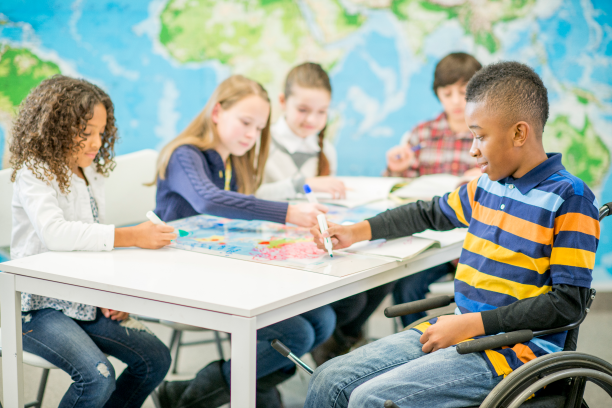
There is a stigma for many special education students that can affect their self-esteem and confidence. One way to boost social, emotional, and academic performance is inclusion. Students of all cognitive levels and backgrounds can achieve amazing things In the inclusive classroom, so let’s take a closer look at some of the benefits of inclusion.
What is Inclusive Education?
In a nutshell, inclusive education means classrooms with diverse learners, with special education students given equal access to the same educational framework as their peers get. Inclusion models have people with disabilities working alongside general education students. Teachers deliver the same lesson to the entire class but with additional supports and differentiation for children with special needs. In a co-teaching classroom, general ed teachers and special education instructors work in tandem. You will find full, partial, and hybrid approaches where specialists “push in” to classes instead of pull students out for instruction. No matter which specific inclusion model schools adopt, students receive an exceptional education, substantial support, and a fostering environment for success.
Why Inclusion is Important in the Classroom
Inclusion is critical for special education students to achieve their highest potential. According to the Individuals with Disabilities Act (IDEA), students need to engage in the Least Restrictive Environment (LRE) to maximize equity and access to learning. Inclusion satisfies this legal requirement, as special education students work in the general education setting as much as possible. Students with learning challenges can make significant advances in academic and interpersonal skills in the inclusive classroom.
Special ed teachers serve a crucial role in the successful inclusion approach. They use specially designed curriculum and instructional strategies to engage students, differentiating instruction to reach learners with various challenges and needs. Depending on the inclusion approach, special education teachers enhance the lessons of the general education teacher, instruct small groups with proven tactics, or work with individuals to reinforce learning throughout the class period.
However, schools need effective special education teachers to help run inclusive classrooms smoothly. Because they play such an essential role, finding the right individual for your school is vital. Soliant is the ideal staffing solution for any director of special education searching for the perfect staff, as we only provide top-notch special ed teachers that will execute any inclusion goals.
What are the Benefits of Inclusion for Special Education Students?
There are many advantages to the inclusive classroom for students and teachers alike. Besides creating an enriched academic environment that challenges students, these classes also improve their math and writing skills and boost social skills. Some of the specific benefits for students and educators include:
Provides Support for All Students
Special education students have various physical and learning challenges and needs. Inclusive classrooms allow all students to receive services and support, as specialists like OTs, speech therapists, and school psychologists are frequently brought into inclusive setups to help learners in class. Teachers can efficiently serve all kids using this model, ensuring that they meet any child’s specific needs.
Makes Differences Less Different
Inclusive classrooms foster togetherness and community. Some students in special day classes may not feel accepted in the overall school community, but inclusive classrooms can ease that divide. These learning groups are full of diverse learners, and the addition of special education students only makes the class more nuanced, showing kids that we all have strengths and challenges.
Fosters a Caring Environment
Special education students in inclusive rooms get to be involved in a more normalized school experience, fostering a school culture of respect. Students often feel more connected to each other as they build teamwork and compassion than they might otherwise, connecting general education and special education kids within the class. Special education students often miss out on opportunities to make new friends, but inclusion can unlock those possibilities.
Helps With Students’ Academic Goals
Inclusive classrooms give special education teachers a unique pathway to ensuring academic success for their students. Special ed students have Individualized Education Programs (IEPs), which relay eligibilities, goals, objectives, and accommodations. Teachers can use the IEP to ensure they tailor their instruction to individual students’ needs. By having a broad and diverse group of learners, teachers can differentiate their instruction easily, work in small groups, and adhere to IEP goals and objectives effectively.
How to Create an Inclusive Classroom
Creating a dynamic, inclusive classroom involves more than mixing special ed students in with general education peers. Special education teachers can implement many tools and strategies to ensure student engagement across the board. For example, teachers can strategically group students for cooperative learning, encouraging structured socialization and academic growth for all. Special education students, in particular, will benefit from working with various peers, giving them the ability to bounce ideas and make friends. Special ed teachers can also improve their skills in specialized areas (like Autism, deaf and hard-of-hearing, visual impairments, etc.) to better meet all needs. Teachers can differentiate lessons and activities to meet IEP objectives and engage students, appealing to their strengths and learning styles. Educators can adjust their grading to be less peer-competitive, ensuring that students are all given a fair chance to show performance in their own ways.
Final Thoughts on Inclusion for Special Education Students
There are many benefits to special education students who participate in an inclusive program. All learners receive additional support, whether from the general education teacher, special ed teacher, or specialists who come into the room to service students. The differences among classmates become points of strength and individuality, creating a caring atmosphere, and the approach ensures that teachers can help kids meet their IEP goals. Special education teachers, particularly, are essential to inclusion. Having a reliable and dedicated special ed teacher can instantly impact the value of the inclusive classroom, as they use specialized tactics and differentiation to maximize all learners’ outcomes.
Find special education teacher jobs by searching through our available opportunities.